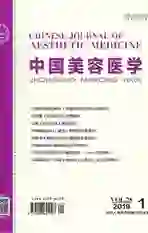成人骨性Ⅱ类不同垂直骨面型患者切牙区牙槽骨面积锥形束CT研究
2019-03-01孙毅
[摘要]目的:应用锥形束CT比较不同垂直骨面型的成人骨性Ⅱ类患者上下颌切牙牙根周围牙槽骨面积的大小。方法:选择骨性Ⅱ类患者45例,根据FMA角分为低角型15例、均角型15例、高角型15例。应用Dolphin Imaging11.5三维软件分别测量上下颌切牙牙根周围不同水平牙槽骨的横断面面积,采用方差分析比较实验数据。结果:低角组患者上颌切牙在根颈1/3处骨面积最小(P<0.05),在根尖1/3处骨面积大于高角组(P<0.05);低角组患者下颌切牙在根中1/3水平处骨面积大于高角组患者(P<0.05),在根尖1/3水平处骨面积最大(P<0.05)。结论:低角组患者上下颌切牙根尖周围骨质较多,高角组患者较少。
[关键词]垂直骨面型;骨性Ⅱ类;切牙;骨面积;CBCT
[中图分类号]R783.5 [文献标志码]A [文章编号]1008-6455(2019)01-0119-03
Study on Alveolar Area around Incisors among Different Vertical Facial Types of Adult Skeletal Class Ⅱ Patients with CBCT
SUN Yi
(Department of Orthodontics,Xiamen Medical College Affiliated Stomatological Hospital, Xiamen 361003,Fujian,China)
Abstract: Objective To compare alveolar area around upper and lower incisors among three vertical facial types of skeletal Class Ⅱ patients with cone beam CT. Methods 45 skeletal Class Ⅱ patients were divided into 15 low angle cases, 15 average angle cases, and 15 high angle cases by the FMA. The CBCT images were reconstructed by three-dimension Dolphin Imaging 11.5 software. Alveolar area on three levels around incisor roots was measured on cross sections. The measurements were analyzed using ANOVA. Results In upper incisors, the area around root at apical level of low angle patients was greater than high angle patients, while low angle patients had the least value at the cervical level. In lower incisors, the area around root at middle level of low angle patients was greater than high angle patients, and the area around root at apical level are greater than that in other two groups. Conclusion The amount of alveolar rounding upper and lower incisors in low angle patient was more than that of the other types. The high angle patients displayed the least bone area.
Key words: vertical facial type; skeletal Class Ⅱ patients;incisor; bone area; cone beam computed tomography
成人骨性Ⅱ類错牙合是临床上常见的一种错牙合畸形,Pancherz[1]统计发现46%~76%的Ⅱ类患者为骨性错牙合。对于成人非严重骨性Ⅱ类错牙合患者的治疗中,要达到改善拥挤度和突度的目的,常规设计选择拔除四个前磨牙内收前牙作为治疗计划。Garib等[2]认为唇舌侧的牙槽骨骨质厚度是牙齿移动的界限,当牙齿的移动突破了这一界限时就可能带来牙周组织损伤等不良后果。为实现切牙在牙槽骨中安全、有效的移动,全面了解治疗切牙在牙槽骨中的位置十分重要,本研究应用锥形束CT(Cone beam computed tomography, CBCT)结合Dolphin Imaging 11.5三维软件对治疗前成人骨性Ⅱ类错牙合患者上下颌切牙牙根周围的牙槽骨面积进行测量,比较不同垂直骨面型患者间切牙牙根周围牙槽骨面积的差异,为临床诊断、矫治方案的制定、疗效的预测以及风险的规避提供参考依据。
1 材料和方法
1.1 研究对象:筛选成人骨性Ⅱ类患者共45例,其中男21例,女24例,年龄20~35岁,平均年龄26.7岁。纳入标准:①ANB>4.7°;U1-L1<125°;②牙列拥挤度≥8mm;③前牙无明显扭转、畸形;④无正畸治疗史。根据眶耳平面-下颌平面角(FMA),FMA>36.9°为高角型、FMA≤25.7°为低角型、FMA25.7°~36.9°为均角型[3],其中高角组15例、均角组15例、低角组15例。所有研究对象知情并同意参与该项研究。
1.2 研究方法
1.2.1 CBCT扫描:應用CBCT(New Tom VGi,放射线量:50mSv,扫描层厚:0.125mm,FOV:150mm×150mm),在电流8.0mA、电压90kV条件下旋转360°拍摄,拍摄时所有患者均采用自然头位。
1.2.2 测量方法与项目:将生成的DICOM软件导入Dolphin Imaging11.5(Dolphin Imaging & Management Solutions, Chatsworth,CA)三维软件中。利用Orientation功能对所有患者头颅进行统一定位,确保所有研究对象在相同的头位下进行测量(见图1)。打开Edit功能下,在MPR(Multi-planner reformation, 多平面重建)界面(见图2)内调节坐标使其在横断面垂直穿过牙体的颊舌向最宽处(见图3),在矢状面上,垂直牙根长轴,并获得牙根冠1/3(S1)、根中1/3(S2)、根尖1/3(S3)处的横截面,分别测量牙根在三个水平的根周围骨面积。测量时,选取平分该牙与邻牙的唇、腭侧最突点连线的中点的连线作为分界线,牙周骨面积等于牙总面积减去牙根面积[4](见图4)。
1.3 统计学分析:使用SPSS 18.0软件对数据进行单因素方差分析(one-way ANOVA),若方差齐,组间两两比较采用 LSD-t检验;若方差不齐,组间两两比较采用Dunnetts T3检验,检验水准α=0.05。
2 结果
2.1 上颌切牙测量比较:S1水平骨面积在低角组与均角、高角组间有显著性差异(P<0.05),低角组值最小;S3水平骨面积在高角组与低角组间有显著性差异(P<0.05),低角组值较大,见表1~2。
2.2 下颌切牙测量比较:S2水平骨面积在高角组与低角组间比较,有显著性差异(P<0.05),低角组值较大;S3水平骨面积在低角组与均角、高角组间有显著性差异(P<0.05),低角组值最大,见表3~4。
3 讨论
3.1 研究方法的准确性:三维测量的准确性在牙槽骨测量的准确性和可靠性研究中,国内外Jakob等[5]和Woelber等[6]已证明,锥形束CT在牙和根周组织测量方面有高度的精确性和可重复性,尤其是它的多功能三维重建功能,为牙齿矫治的术前诊断、设计提供了更多的信息;另外,Takeshita等[7]也对根尖片、曲面断层片以及锥形束CT三者在评估牙槽骨缺失的成像准确性方面进行了比较研究,发现锥形束CT的准确度明显高于另外两者。因此,本实验选择应用的New Tom VGi锥形束CT分辨率能够达到0.125mm,可以满足对成人骨性Ⅱ类不同垂直骨面型的切牙区牙槽骨形态特点和切牙位置的研究。
Arieta-Miranda等[8]选取三组样本,每组各15例样本,对不并矢状骨面型患者的CBCT进行髁突位置的研究,发现Ⅱ类和Ⅲ类患者的关节上间隙小于Ⅰ类患者,而且Ⅱ类和Ⅲ类患者髁突到关节隆突的前间隙都与Ⅰ患者的有统计学差异。本研究中对选取的样本进行统计学分析后,得出一些测量值组间有一定的统计学差异,这对临床的诊断有一定的参考意义,如果能够增大样本量,本研究将更加完善。
3.2 测量方法的比较:Thongudomporn等[9]分别取牙根顶部、中部、尖部三个水平面,测量拔出前磨牙内收上颌切牙后牙槽骨厚度的变化,发现牙根顶部、中部腭侧牙槽骨厚度减少量范围为0.34~0.59mm,前后差异无统计学意义,但是根尖部腭侧牙槽骨厚度与切牙根尖的移动量呈负相关,提示在内收切牙的过程中,要注意切牙转矩的控制,减少医源性牙槽骨的损伤。本研究亦选取上下颌切牙在根颈1/3、根中1/3以及根尖1/3三个水平截面,直接测量各水平面处牙根周牙槽骨面积,此种测量方法比测量牙槽骨宽度能够更直接、更准确地反映根周牙槽的总量,也减少了测量误差。
3.3 不同垂直骨面型切牙根周的牙槽骨面积:以往的研究,大部分是关于牙根尖牙槽骨宽度和高度的研究,Zhou等[10]对上颌前牙区牙槽骨的研究中,发现切牙牙根间的牙槽骨形态为宽短型,中切牙与中切牙间、中切牙与侧切牙间的牙槽骨宽度分别为(8.89±0.95)mm,(7.49±0.60)mm,不同牙位牙根间的牙槽骨宽度不同。Yang等[11]在牙根矢状轴方向上牙槽骨厚度的测量中发现,距根颈根尖方向2mm、根中、根尖三个水平的牙槽骨厚度超过2mm的只占2.2%,提示上颌前牙牙根靠近唇侧皮质骨,大部分牙位的唇侧骨质较薄。Lee等[12]研究发现,上颌中切牙和侧切牙在釉牙骨质界下3mm处的牙槽骨厚度分别为5.13mm、4.58mm,相应牙位牙根腭侧骨厚度大于牙根唇侧骨厚度。Gracco等[13]对不同垂直骨面型患者上颌切牙矢状面牙槽骨厚度的研究发现,低角型患者牙槽骨厚度大于高角型患者,低角和均角患者根尖至舌侧骨皮质的距离较高角组大,三种骨面型中,中切牙的牙槽骨厚度均大于侧切牙的牙槽骨厚度。以上宽度或高度的测量无法全面的反映牙根周围骨质的真实情况,因此本研究通过对牙根周围骨面积的测量来了解不同垂直骨面型根周骨质的情况。
本研究通过比较成人骨性Ⅱ类错牙合上下颌切牙三个水平面根周骨质面积,发现高角型患者根尖水平骨面积较小,这与Baysal等[14]对Ⅰ类和Ⅱ类均角、高角患者下颌切牙区牙槽骨厚度进行比较研究发现类似,其中Ⅰ类患者的唇侧牙槽骨厚度明显大于Ⅱ类患者,Ⅱ类高角患者根尖更加靠近唇侧皮质骨,表明Ⅱ类高角患者下切牙的移动范围较小。因此,成人骨性Ⅱ类患者在拔出前磨牙内收前牙的过程中,对高角型患者更应注意根尖部的控制,避免骨开窗、骨开裂情况的发生。如果仅仅靠牙齿的移动无法满足前牙覆盖的代偿需要,则需要辅助正颌外科来矫正颌间关系,获得理想的软组织侧貌,建立稳定的咬牙合。
[参考文献]
[1]Pancherz H,Zieber K,Hoyer B.Cephalometric characteristics of Class Ⅱ division 1 and Class Ⅱ division 2 malocclusions: a comparative study in children [J].Angle Orthod,1997,67(2):111-120.
[2]Garib DG,Yatabe MS,Ozawa TO,et al.Alveolar bone morphology under the perspective of the computed tomography:definingthe biological limits of tooth movement[J].Dental Press J Orthod,2010,15:192-205.
[3]傅民魁.口腔正畸學[M].北京:人民卫生出版社,2007:102-103.
[4]Prasanthi NN,Rambabu T,Sajjan GS,et al.A comparative evaluation of the increase in root canal surface area and canal transportation in curved root canals by three rotary systems: a cone-beam computed tomographic study[J].J Conserv Dent,2016, 19(5): 434-439.
[5]Neubauer J,Benndorf M,Ehritt-Braun C,et al.Comparison of the diagnostic accuracy of cone beam computed tomography and radiography for scaphoid fractures [J].Sci Rep, 2018,8(1):3906.
[6]Woelber JP,Fleiner J,Rau J,et al.Accuracy and usefulness of CBCT in periodontology: a systematic review of the literature[J].Int J Periodontics Restorative Dent,2018,38(2):289-297.
[7]Takeshita WM,Vessoni Iwaki LC,Da Silva MC,et al. Evaluation of diagnostic accuracy of conventional and digital periapical radiography, panoramic radiography,and cone-beam computed tomography in the assessment of alveolar bone loss[J].Contemp Clin Dent,2014,5(3):318-323.
[8]Arieta-Miranda JM,Silva-Valencia M,Flores-Mir C,et al.Spatial analysis of condyle position according to sagittal skeletal relationship, assessed by cone beam computed tomography [J].Prog Orthod,2013,14:36.
[9]Thongudomporn U,Charoemratrote C,Jearapongpakorn S.Changes of anterior maxillary alveolar bone thickness following incisor proclination and extrusion[J].Angle Orthod,2015,85(4):549-554.
[10]Zhou Z,Chen W,Shen M,et al.Cone beam computed tomographic analyses of alveolar bone anatomy at the maxillary anterior region in Chinese adults[J].J Biomed Res, 2014, 28(6):498-505.
[11]Yang G,Hu WJ,Cao J.et al.Measurement of sagittal root position and the thickness of the facial and palatal alveolar bone of maxillary anterior teeth[J].Zhonghua Kou Qiang Yi Xue Za Zhi,2013,48(12):716-720.
[12]Lee SL,Kim HJ,Son MK.et al.Anthropometric analysis of maxillary anterior buccal bone of Korean adults using cone-beam CT[J].J Adv Prosthodont,2010,2(3):96-92.
[13]Gracco A,Lombardo L,Mancuso G,et al.Upper incisor position and bony support in untreated patients as seen on CBCT[J].Angle Orthod,2009,79(4):692-702.
[14]Baysal A,Ucar FI,Buyuk SK,et al.Alveolar bone thickness and lower incisor position in skeletal Class I and Class Ⅱ malocclusions assessed with cone-beam computed tomography [J].Korean J Orthod,2013,43(3):134-140.
[收稿日期]2018-06-01 [修回日期]2018-08-02
编辑/李阳利
本文引用格式:孙毅.成人骨性Ⅱ类不同垂直骨面型患者切牙区牙槽骨面积锥形束CT研究[J].中国美容医学,2019,28(1):119-121.
